Do you know of anyone who just seems so organised that you wish you had some of their magic power?
I remember when I started out in my career. When I was running around like a headless chook, grabbing onto each and every opportunity. At the same time being supportive of my colleagues and being seemingly super productive. I was young, hungry and ambitious.
Then there was one of the company directors: Brent.
Brent seemed super laid back, 100% organised, had all the time in the world to listen and provide guidance. His desk was so immaculate that at times I wondered what he actually did, but he always seemed in control.
He was soon to retire and had been successful in business. He had a massive network of influential people and was well respected.
After I had experienced one hectic month I approached him and asked for help.
How do I get some of what you have Brent?
Well, my experience with Brent goes back nearly 3 decades, but even today I still remember his most important lesson.
He introduced me to the Eisenhower Matrix. In itself, the matrix is deceptively simple. And, there is a good chance that you are already familiar with it. However, the benefit to you is taking the notion that this is a good concept and actually put it into practice.
In this article, I will cover off the essential bits of what the matrix is all about plus some tips on how you can actually implement it into your life.
The Eisenhower Matrix
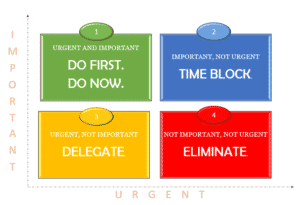
Eisenhower Matrix
Also referred to as the Urgent- Important table, the Eisenhower Matrix helps you prioritise tasks by importance and urgency. It also lets you identify and sort out tasks that you should either delegate or not do at all.
This matrix was formed using the principles invented by the 34th president of the United States, Dwight D. Eisenhower. A principle that came about having to make tough decisions nonstop on which tasks to focus on each day.
Today, the Eisenhower matrix serves as a tool for us to be able to prioritise what’s important and urgent.
Do First
Definition: The first quadrant is meant for tasks that are BOTH important and urgent.
Tasks on the “do-first” are critical for business and must be finished right away. These tasks also have a high financial value to the business.

Why it Matters: These are the tasks that you want done as soon as
possible to avoid adverse consequences.
It is important to manage tasks in the first quadrant very well. And, since they are of high value to the business, you do want to be aware of them even if you are not personally actioning them yourself.
Examples: Replying to time-sensitive e-mails; finishing deadline-driven projects; responding to genuine employee emergency. Something that your business is involved in that is affecting one of your A grade customers etc.
How to: Make sure that the task really does belong in this quadrant.
Is it really urgent and is there a direct and significant financial benefit to the business if done correctly?
So what do you do if a quadrant one task is not in your area of expertise?
You should consider two options in this situation: develop expertise in this area or find someone who could better do this than yourself. I.e. reposition the task to someone else’s quadrant one. But what is important is making sure that a particular task really belongs in this quadrant. Is it urgent AND does it have a high commercial value or cost to the business?
Time Block & Get Done
Definition: The tasks in the second quadrant are important, BUT not urgent.
These tasks are more in line with your long-term goals and so in reality, you’d want to be spending more time on this list than what most people do. Depending on your exact circumstances you could be spending between 5 and 20% of your time in this quadrant.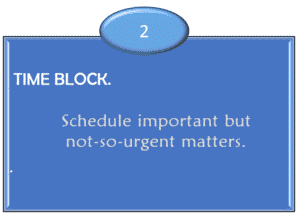
Why it Matters: In my experience, if these tasks are not done, then over time they will often become urgent.
And, usually require a whole lot more resources to complete as they have an element of fixing in them as well. So with this in mind consider how many of your quadrant one tasks, should have been quadrant two tasks a few months or a year ago. If you want to move your business, your life forward, beyond just incremental improvements, then master this quadrant.
Examples: Creating your SOAP, or overall business strategy is a classic example.
90-day planning is another. After completing your SOAP & 90-day planning, you will have an insight into what proactive tasks you should be doing. All to move your business forward. For instance, I had a hairdressing client, a very good one that was operating in a highly competitive industry.
They identified for their 90-day theme that employee engagement was the most critical factor to get right for their business. So off this, they developed strategies within their 90-day plan to make this happen. Other typical examples beyond planning for your business is you! Your health, your exercise, your stress levels. It will make no difference to you in the “now” if you don’t do these tasks, but the long-term cost to the business, if you don’t get going on these tasks, is massive.
How to: I have found that people easily confuse urgent matters as important, which, of course, is often not always the case.
And in a similar fashion, they sometimes confuse not urgent tasks as being of less importance. This situation often occurs when people have spent much of their time in quadrant one territory. After a while life just seems like quadrant one! From experience, I found that the only way I can become productive in this quadrant is by taking time out. On a regular basis take time out where there are no distractions and you can focus on what really matters.
Having a hard time defining your long-term goals?
Delegate
Definition: Have you ever felt that you give too much importance to a task yet looking back, it was actually not that important? Or thought something must be accomplished right away although, in reality, it doesn’t need to be?
If so, welcome to the club!
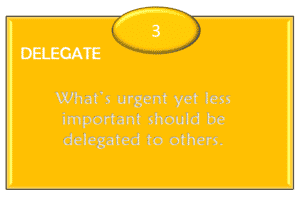 An exercise I often give to my clients is for them to consider what their financial cost is to their own business. The answer to this question is not what they pay themselves but rather the potential earnings of the business. Usually, they discover that their cost is 3 to 10 times more than whatever their highest paid employee is being paid. So now ask yourself: Is the task that you have been doing for the last hour worth $x/hour?
An exercise I often give to my clients is for them to consider what their financial cost is to their own business. The answer to this question is not what they pay themselves but rather the potential earnings of the business. Usually, they discover that their cost is 3 to 10 times more than whatever their highest paid employee is being paid. So now ask yourself: Is the task that you have been doing for the last hour worth $x/hour?
Why it Matters: Unless someone in your business is working on tasks that get the business closer to achieving identified goals, then by default no one is. Therefore, there is little chance of achieving said goals.
I think by default, we humans are all a little lazy. We tend to take the easy route rather than the more difficult option. So by default spending time in the Urgent quadrants is actually easier, and often more satisfying than stepping into quadrant two.
Examples: You’re in the middle of working on your monthly financial report and the phone rings.
At this stage you have no idea what the call is about, what should you do?
Here is another:
You are making prospecting calls, you have a list of 100 hot prospects. But while you are doing this one of your employees barges in and offloads a frustration he has with an irate customer. Yeah you know where this one is going, you have been down that rabbit hole before.
Examples of quadrant three activities are so numerous in our daily lives that you often don’t recognize them for this reason. These distractions are or could appear to be urgent at the time it is happening yet you don’t have to be the one to do it.
How to: You will never eliminate tasks in this quadrant but what you should be doing is delegating as many of these as possible to your team members.
In terms of your own leadership development, this is the quadrant where your coaching of employees comes into play. In the example above, how could you coach your employee on how to manage an irate customer rather than offloading the problem onto you?
By offloading they are by default also handing responsibility from themselves to you! Root cause analysis (RCA) is another powerful tool to be used in this quadrant. After identifying what these tasks are, how many of them can be eliminated upstream through your RCA exercise? What can be automated (developing systems) or delegated to lower-cost employees?
Eliminate
Definition: The fourth quadrant is tasks that are neither urgent nor important, essentially they are simply a waste of time.
And we all have some of these, it is just a question of how much of your day is taken up with these tasks.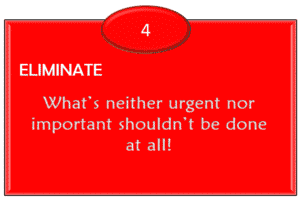
Why it Matters: By steering clear of these tasks, you will be able to free up time to deal with your second quadrant tasks.
The financial return to your business of quadrant one tasks maybe $0 to a few dollars. So unless there is some intrinsic benefit to you personally by doing these tasks, have the mindset of eliminating them.
Examples: Mindless web browsing or the curse of social media are typical examples.
Multitasking is another classic! Multitasking leads to a loss in productivity. How often are you managing a whole bunch of small tasks, that are not that important, but you want them completed, so you managed them all at the same time? Like check your emails, respond to a Facebook post, follow a link from another email, do a Google search, etc.
Perfectionism is another. At what point do you get an 80% return on your task? If it took you 20 hours to reach 80% completion, it will likely take you another 20 hours to get you to 90%. How perfect does it have to be? What comes into play here is the law of diminishing returns.
How to: Over-refining details on a project needs to be considered a flaw, not an asset.
What is your minimum viable product for a particular task? Always consider what the urgency level for this particular task is and what the financial return to the business is. The strategy is simple for this quadrant. Identify what these tasks are and eliminate or automate them.
Final thoughts
Undertaking an audit check of the tasks that you are doing is a great way to identify where your time is spent. It is a real pain doing these checks, but the result will provide you with valuable information.
Once you have some hard figures in front of you, you will be able to calculate what it could mean to you financially. If you were able to do more quadrant two tasks, in particular, after all, these are the higher paying tasks that will have a long-term positive impact on your business.
The Eisenhower Matrix is a great tool to help you prioritise our daily tasks, but it is not foolproof. If your goals are not well-defined, it can be hard to determine if something is important or not.
So, if you’ve tried using this matrix before but you believe that you are still not implementing it correctly or benefiting from it, then it’s time to revisit your overall strategy. Have you considered creating your own SOAP and 90-day planning?
Get your free Eisenhower Matrix PDF worksheet here!
Need a hand with your worksheet, SOAP, or 90-day planning?

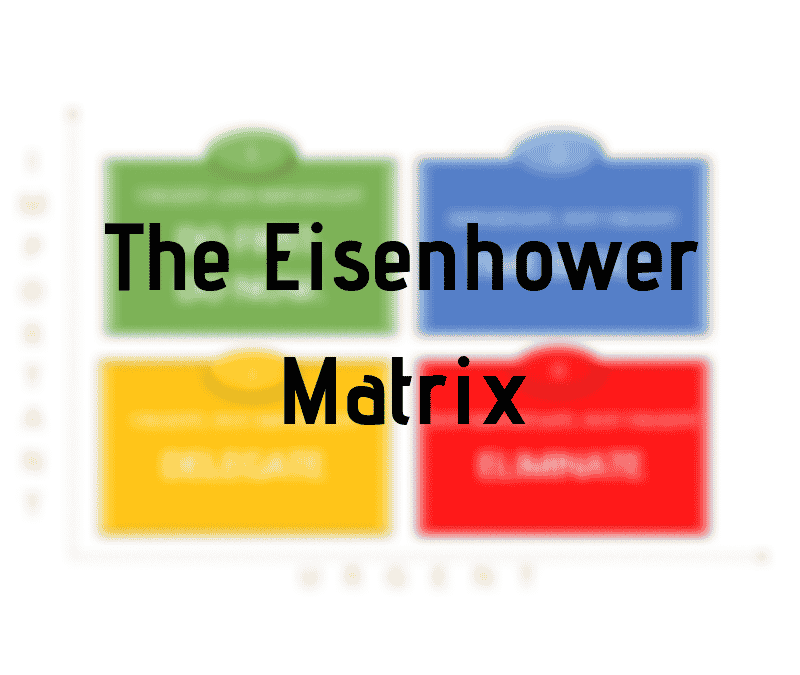
Recent Comments